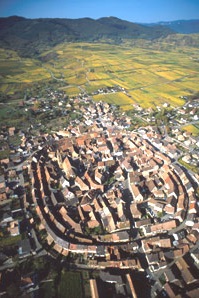
I love Alsatian wine. In my salad days, drowning in Firbank and the romances of William Morris, whenever the lovers shared a goblet of golden wine, I imagined it must be some silken, perfumed vintage from Alsace. Last Tuesday, that old prejudice was confirmed. Drawn by an invitation from Mark Bruni of RKW Imports, I slid up to Ici, J-P Challet’s pretty little gastronomic bower on Harbord Street, for a lunch with Marc Beyer of the ancient Alsatian house of Léon Beyer.
Much revered in Quebec, his wines have been absent from Ontario’s liquor stores for several years but some will now be returning to the Vintages lists. Hooray, for these are wines of extraordinary elegance and balance that should be savoured. And, as the genial Mr Beyer was quick to point out, they are distinct from the Alsatian regulars on the LCBO’s general list in that they are bone dry, lacking the hefty residual sugar that lurks behind other labels. Which makes Beyer’s wines such useful tools for the sommelier: they work brilliantly with food.
Before we put that theory to the test, however, we tasted a small sample of Léon Beyer’s range, beginning with three Rieslings, each one crisp, clean and sharp as a blade. The youngest – the 2012 Rielsing Reserve, was all about lemons and white flowers. The 2007 “les Ecaillers” had much more going on, with minerality starting to dominate the fruit and hints of petrol invading the nose. The name, incidentally, means “the oyster shuckers” and refers to the fact that, back in 1954, Marc Beyer’s father introduced the first oyster-shucking competition at the gastronomical club he founded, Club Prosper Montagné, and chose this splendid wine as the ideal accompaniment to the thousands of shucked oysters that the club members were then obliged to eat. The third Riesling was the top-of-the-line 2005 Comtes d’Eguisheim, a wine from the Grand Cru Pfersigberg vineyard, now in the glory of its maturity. That minerality and petrol was there in spades but there was still fruit shining through on the long, long finish. Beyer bottles this wine young to retain those primary aromas, then keeps it ageing in the bottle for six years before selling it.
On to the 2011 Gewurztraminer – bone dry and much more delicately floral than the lush, lychee-perfumed wines from other houses. The balance of aromatics and acidity was brilliantly achieved – a great wine for smoked fish or salmon roe canapés. The 2005 Comtes d’Eguisheim Gewurztraminer was on an altogether more exalted level, perfumed, dry, spicy, fresh, extraordinarily elegant. Marc Beyer subtly dropped the names of a couple of white Burgundies into the conversation and with good reason. This wine could stand beside the best.”It’s amazingly good with Lobster à l’Americaine,” he said. I have put the idea on my bucket list.
All this time, J-P Challet and his small brigade had been heads-down in the kitchen and now their offerings began to appear. First came a little plate of three compositions to accompany the fresh, fruity, slightly smoky 2011 Pinot Gris. I was amazed at how well it worked with a delicate, herbal veal tartare: there was an edge of mustard in the recipe and it brought out an unexpected spiciness in the wine. Silky, finely sliced salmon carpaccio was another delightful marriage, as were a tumble of finger-sized, curiously greenish, deep-fried objects that turned out to be fritters of soft, creamy, subtle pike quenelle.
Next, Marc Beyer introduced his only red, a young, fresh 2011 Pinot Noir, served slightly chilled. Léon Beyer uses no oak. This red was all primary fruit aromas and youthful energy – it’s very popular right now in the bistros of Paris and is also the house wine, served by the glass, at the Ritz. Yes, it’s light and relatively simple but it worked very well with our main course of squab (beautifully timed) in a bordelaise sauce with a fried mushroom and truffle crosmequis, potato croquettes and a soft pillow of orange-and-carrot mousse. In Alsace they are quite happy to serve this low-tannin Pinot with fish, just as they like to pair a good Pinot Gris with partridge and poultry.
The pudding wine was a real treat – the 2004 Vendanges Tardives Gewurztraminer, a late-harvest gem of refreshing grace with a subtle sweetness and a complex bouquet of floral and fruity aromas. Again, that spicy undertone was unmistakable. J-P paired it perfectly with a trembling cube of goat cheese cheesecake, a lemon tart with a good inch of tangy lemon curd, light as air, on the merest suggestion of soft pastry, and a crème brûlée that may have been a tad too sweet for the wine but was welcomed warmly anyway by the generous company.
All in all, a lovely way to spend Tuesday lunchtime.
